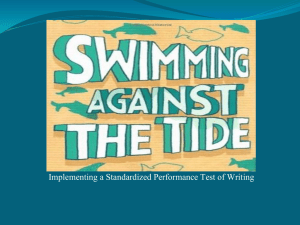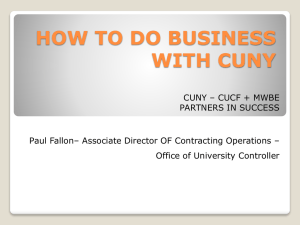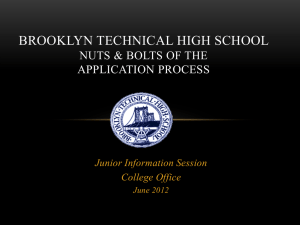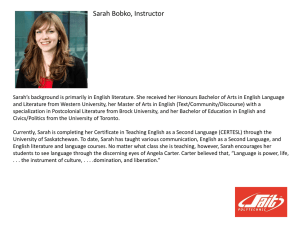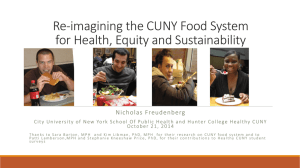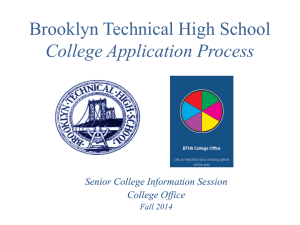PPTX
advertisement
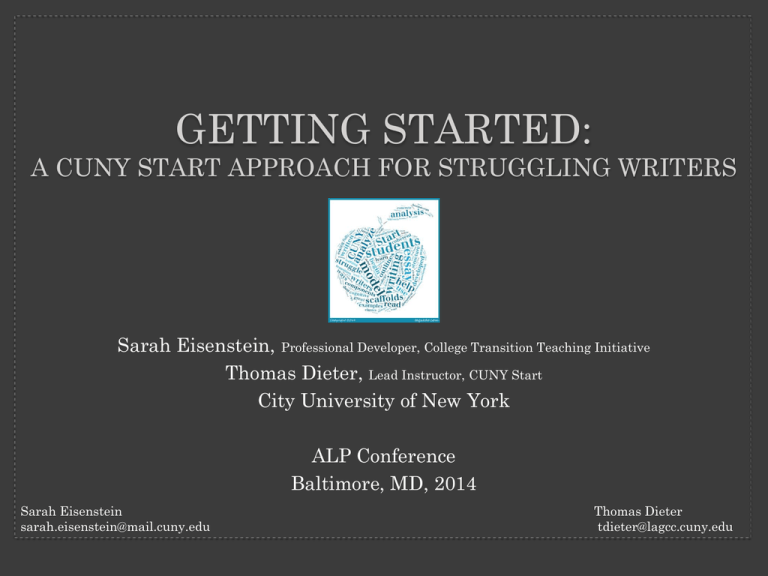
GETTING STARTED: A CUNY START APPROACH FOR STRUGGLING WRITERS Sarah Eisenstein, Professional Developer, College Transition Teaching Initiative Thomas Dieter, Lead Instructor, CUNY Start City University of New York ALP Conference Baltimore, MD, 2014 Sarah Eisenstein sarah.eisenstein@mail.cuny.edu Thomas Dieter tdieter@lagcc.cuny.edu PRE-WORKSHOP ANALYSIS Welcome! Please read the student essay on your seat and make some notes while considering the following questions: What do you observe about this student’s writing? What strengths and weaknesses do you notice? Some context: This is an intake essay written by a CUNY Start student in response to an article about a couple who won the lottery but gave away their winnings. CUNY Assessment Test of Writing (CATW) Directions: Read the passage above and write an essay responding to the ideas it presents. In your essay, be sure to summarize the passage in your own words, stating the author’s most important ideas. Develop your essay by identifying one idea in the passage that you feel is especially significant, and explain its significance. Support your claims with evidence or examples drawn from what you have read, learned in school, and/or personally experienced. Remember to review your essay and make any changes or corrections that will help your reader follow your thinking. You will have 90 minutes to complete your essay. Sarah Eisenstein sarah.eisenstein@mail.cuny.edu Thomas Dieter tdieter@lagcc.cuny.edu WORKSHOP AGENDA CTTI & CUNY Start: A Brief Introduction Characteristics of Developmental Writers Approaches to Scaffolding Writing Cognitive Apprenticeship: Modeling, Scaffolding, Fading and Coaching Closing: Personal Reflection Sarah Eisenstein sarah.eisenstein@mail.cuny.edu Thomas Dieter tdieter@lagcc.cuny.edu CUNY COLLEGE TRANSITION TEACHING INITIATIVE (CTTI) CTTI provides research-based professional development and curriculum development for college transition. CTTI has worked with a range of programs and faculty, most notably helping to create and develop CUNY Start. Sarah Eisenstein sarah.eisenstein@mail.cuny.edu Thomas Dieter tdieter@lagcc.cuny.edu A television still from a recent NY1 story. Sarah Eisenstein sarah.eisenstein@mail.cuny.edu Robert Stolarik for The New York Times Thomas Dieter tdieter@lagcc.cuny.edu CUNY START A BRIEF HISTORY CUNY Start began in 2007 as an intervention for GED recipients at two community colleges in the CUNY system. Today, the program has expanded to eight CUNY campuses and now serves both GED recipients and HS graduates. Total students served to date: 3,400 Sarah Eisenstein sarah.eisenstein@mail.cuny.edu Thomas Dieter tdieter@lagcc.cuny.edu CUNY START RESULTS Outcomes: Fall 2009 – Fall 2013 Most students in the full-time program enter with remedial needs in all three skills areas. After one semester, 49% of students become fully proficient. Those who don’t become fully proficient make significant gains. Sarah Eisenstein sarah.eisenstein@mail.cuny.edu Thomas Dieter tdieter@lagcc.cuny.edu CUNY START PROGRAM STRUCTURE & TRAINING 15-18 week program with two opportunities to retake CUNY Assessment Tests $75 student fee; no financial-aid drawdown Intensive study: - Full-time Program: 25 hours/week, or - Part-time Program: 12 hours/week Rigorous instruction by highly trained teachers and advisors using a model of cognitive apprenticeship. Sarah Eisenstein sarah.eisenstein@mail.cuny.edu Thomas Dieter tdieter@lagcc.cuny.edu CHARACTERISTICS OF DEVELOPMENTAL WRITERS Developmental writers need support in many ways, including: Sarah Eisenstein sarah.eisenstein@mail.cuny.edu Thomas Dieter tdieter@lagcc.cuny.edu CHARACTERISTICS OF DEVELOPMENTAL WRITERS Developmental writers need support in many ways, including: Development Organization Analysis Clarity Control Sarah Eisenstein sarah.eisenstein@mail.cuny.edu Thomas Dieter tdieter@lagcc.cuny.edu APPROACHES TO SCAFFOLDING WRITING Using the writing process to support students to develop their own voices: Brainstorming Free-writing Drafting and revising Sarah Eisenstein sarah.eisenstein@mail.cuny.edu Thomas Dieter tdieter@lagcc.cuny.edu APPROACHES TO SCAFFOLDING WRITING Essay plan Before you write your essay, plan the points you want to make, and find evidence to back up your ideas. Try using T.E.E.L. to help you structure each paragraph. Topic Sentence – this is a statement about what point your paragraph will make. Example – this is evidence to back up your point. Explanation – this is where you demonstrate that you understand your example, and explain how it supports your point. Link – this is where you sum-up your point, and then introduce your next idea. Essay question Sarah Eisenstein sarah.eisenstein@mail.cuny.edu Paragraph 1 Paragraph 2 Paragraph 3 Topic sentence Topic sentence Topic sentence Example Example Example Source: Source: Source: Explanation Explanation Explanation Link Link Link Thomas Dieter tdieter@lagcc.cuny.edu WITHOUT MENTAL MODELS OF ESSAYS, STUDENTS MAY: Get overwhelmed and not know how to get started Not understand the rationale for teachers’ feedback; revisions can be rote and not carry over to the next essay Misuse scaffolds Sarah Eisenstein sarah.eisenstein@mail.cuny.edu Thomas Dieter tdieter@lagcc.cuny.edu COGNITIVE APPRENTICESHIP Modeling Scaffolding Fading Coaching Sarah Eisenstein sarah.eisenstein@mail.cuny.edu Thomas Dieter tdieter@lagcc.cuny.edu COGNITIVE APPRENTICESHIP MODELING Scaffolding Fading Coaching Sarah Eisenstein sarah.eisenstein@mail.cuny.edu Thomas Dieter tdieter@lagcc.cuny.edu MODEL ESSAY ANALYSIS & STUDENT SAMPLE Please read the model essay in response to the “What Are Friends For?” CATW prompt, then fill out the model essay analysis sheet. As you read, make notes on the following: What benefits do you see to starting with this kind of model essay analysis activity? How do you anticipate students will struggle with this activity? Sarah Eisenstein sarah.eisenstein@mail.cuny.edu Thomas Dieter tdieter@lagcc.cuny.edu STARTING WITH FULLY-WRITTEN MODELS In a traditional shoe-making apprenticeship, apprentices could see the master make the whole shoe. Seeing how it looked as a complete whole was necessary for beginning to start work on even one piece of the shoe. Similarly, students need a mental model of a fully developed, coherent essay because having the big picture enables them to work meaningfully on any particular part. Model essays should be fully written and coherent to give a complete picture. (Collins, Brown & Holum, 1991). Sarah Eisenstein sarah.eisenstein@mail.cuny.edu Thomas Dieter tdieter@lagcc.cuny.edu STRUCTURED ANALYSIS OF ACCESSIBLE MODELS For models to work, students need to be able to see how they’re constructed. Students should interact with models in structured ways, so that they can easily identify and reproduce salient features. (Macbeth, 2010; Ponsot & Deen, 1982) Sarah Eisenstein sarah.eisenstein@mail.cuny.edu Thomas Dieter tdieter@lagcc.cuny.edu REFLECTIONS ON THE USE OF MODELS Model Essay Analysis gives teachers and students a grounded starting place. Over time, weaker students become more comfortable using the model-essay structure, and teachers can begin coaching them to strengthen sub-skills. Some students’ essays may become formulaic after a while; students need support and coaching to infuse their own voices into their writing. Sarah Eisenstein sarah.eisenstein@mail.cuny.edu Thomas Dieter tdieter@lagcc.cuny.edu CLOSING PERSONAL REFLECTION How is the model analysis from this workshop similar to and/or different from the scaffolds and models teachers use in your program? How do you imagine you might be able to adapt or use model analysis in your program? Sarah Eisenstein sarah.eisenstein@mail.cuny.edu Thomas Dieter tdieter@lagcc.cuny.edu THANK YOU! Sarah Eisenstein sarah.eisenstein@mail.cuny.edu Thomas Dieter tdieter@lagcc.cuny.edu WORKS CITED Collins, Allan, John Seely Brown & Ann Holum. “Cognitive Apprenticeship: Making Thinking Visible.” American Educator Winter (1991): 1-18. Web. Grubb, W. Norton & Robert Gabriner. Basic Skills Education in Community Colleges: Inside and Outside of Classrooms. New York: Routledge, 2013. Print. Macbeth, Karen. “Deliberate False Provisions: The Use and Usefulness of Models in Learning Academic Writing.” Journal of Second Language Writing 19(2010): 33-48. Web. Ponsot, Marie & Rosemary Deen. Beat Not the Poor Desk: Writing: What to Teach, How to Teach It and Why. Portsmouth: Boynton/Cook Publishers 1982. Print. Sarah Eisenstein sarah.eisenstein@mail.cuny.edu Thomas Dieter tdieter@lagcc.cuny.edu

